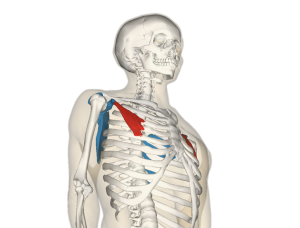I’ve always been convinced the the shoulder is quite possibly the worst designed joint in the body. Which makes it one of the most interesting to treat!! Lets break down the shoulder and shoulder pain generators today:
The bones of the shoulder consist of the humerus, the scapula and the clavicle with the rib cage and neck serving as attachments for ligaments, tendons and muscles. I think the simplest way to look at how the shoulder works is to imagine a golf ball on a tee and then tip it on its side. The golf ball, would be the head of the humerus and the tee would be the glenoid fossa which is actually part of the scapula, or shoulder blade. Often times, the shoulder will be an area of chronic aching and occasional sharp shooting pain.
The list of muscles involved in shoulder movement is pretty extensive, but lets stick to two that are often problematic and can cause shoulder pain. The pectoralis minor and the serratus anterior, although they are often problematic for different reasons.

The Pectoralis Minor is a small but important muscle beneath the Pectoralis Major. It attaches from the front of a few ribs in the middle of your chest to the coracoid process of the scapula. It is difficult to say what the “Primary function” of the pec minor is because it can play so many different roles. It helps in downward rotation of the scapula, internal rotation of the humerus and protraction of the scapula. If you’re reading this on the computer, take note of your current body position. Odds are your shoulder girdle is doing all 3 of these motions. Considering the fact that you likely sit in this position for upwards of 8 hours a day, there is a good chance your pectoralis minor might be suffering! It frequently becomes a muscle that is overactive and tries to work for most of the other area muscles. It can become knotted, tight, full of adhesions and becomes a shoulder pain generator. (If you want a little more detail of the exact opposites to the pectoralis minor, check out this article!)
![By Anatomography (en:Anatomography (setting page of this image)) [CC BY-SA 2.1 jp (http://creativecommons.org/licenses/by-sa/2.1/jp/deed.en)], via Wikimedia Commons](http://upload.wikimedia.org/wikipedia/commons/3/31/Serratus_anterior_muscle_animation_small.gif)
Here is the part that makes diagnosing a little more difficult. It is easy to assume that the tight muscle is the one that is causing your pain which means we stretch and release the muscle. But sometimes… Its the weak muscle that can cause the pain!
So I’ve just described about 1% of the muscles involved in movement of the shoulder, but I would bet that approximately 80% of those in the desk job population suffer from some dysfunction in these 2 muscles.
I can’t know for certain unless I get my hands on your shoulders and do some testing… but if you’re having shoulder issues, pain, aching, numbness, tingling into the arms and hands or neck tightness, then odds are you could benefit from an evaluation.
And as always,
Keep Moving!
